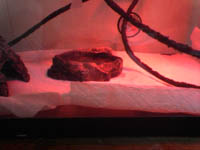
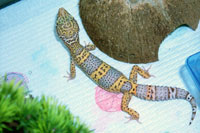
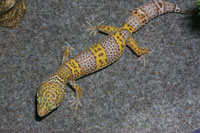

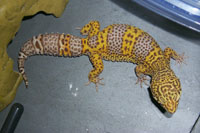
To be honest, I have kept a very poor record of the size of Lucilla since I have received her. I had only made a few attempts at measuring her length, and even then those measurements were probably nothing more than estimates. At I don't even want to start with weighing her. That would require Lucilla to first allow me to handle her for more than a minute or so.
In recent days, I have made an effort to determine Lucilla's size using photographs I've taken of her since I purchased her three months ago. The photographic record is sparce before August 11, but I did take some images about an hour after purchasing her. I took additional images on July 12 and have taken images every few days since August 6. In order to measure Lucilla's length from an image, the image would need to be taken from directly above Lucilla, and have some object in the image to use as a frame of reference, like the entrance to her coconut hut, or a quarter. Some type of object I can measure today. By ratioing Lucilla's length in pixels and the reference length in pixels, then multiplying by the reference length, I can Lucilla's length at the time the image was taken. Appropriate images were found on June 18, August 22, August 30, and September 11 (November 15 added later, see update below).
 |  |  |  | 
|
| June 18, 2005 | August 22, 2005 | August 30, 2005 | September 11, 2005 | November 15, 2005 |
For each image, I measured Lucilla's length using the line tool in Photoshop. I drew line segments along the length of the spine/midline, which is clearly defined by a two parallel lines of spots along the dorsal side. The midline is less clearly defined in the head and tail. For the June 18 image, the midline can not be seen so the lateral length is used. This may lead to a slight underestimate of her size since such a measurement may not take into account any spinal contortions. The reference length was also found by the line tool. The lengths of the line segments are then added up, and divided by the reference length, both in pixels. This gives the ratio between Lucilla's total length and the reference length. I then made a physical measurement (in millimeters for more precision) of the reference length. Multiplying the ratio by the reference length in millimeters, gives Lucilla's length at the time of the measurement in millimeters. For the sake of this page, the millimeter measurements were converted to inches.
| Date | Days since June 18, 2005 | Total Length (inches) |
| June 18, 2005 | 0 | 3.75 |
| August 22, 2005 | 65 | 6.76 |
| August 30, 2005 | 73 | 7.07 |
| September 11, 2005 | 85 | 7.34 |
| November 15, 2005 | 150 | 8.32 |
Based on these measurements, I fit a logistic model to the data. Logistic models take the form of f(x)=c/(1+a*e-b*x). A logistic model may be appropriate since they can correctly model a rapid (but not "infinitely" rapid, as with logarithmic) growth early on that then slows down over time until it grinds to a halt. Using PowerOne Graph, an advanced mathematics program for the Palm OS, I was able to derive a model fit of f(x)=8.442/(1+1.252e-0.0251x), where f(x) is total length and x is the number of days since June 18, 2005. A plot of the data as well as the model can be seen below.
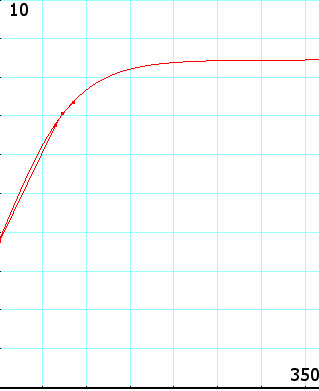
I apologize for the lack of labels on that chart, it is just a screen grab from the mathematics program. The horizontal axis is days since June 18, June 18 is at the origin, and the gridlines are every 50 days. The vertical axis is total length in inches, with 0 at the origin, 10 inches at the top, and the gridlines are every 1 inch. As stated earlier, this model shows a rapid growth rate at the start that gradually slows over time, till it is almost 0 by day 250. This chart also shows the astonishing growth rate Lucilla has encountered over the last three months, growing 3 inches in a little over 3 months and growing more than 1/2 inch in the 20 days between August 22 and September 11. Another reason I like this model is that it predicts a final length of approximately 8.44 inches. Leopard Geckos generally top out between 8 and 9 inches (assuming they are not a giant morph) so this prediction is not out of line with expectations.
I plan to try to collect a measurement of Lucilla's size about once every week or two, to see how her growth matches with this prediction. I also am looking at past images to attempt to refine the model further. I collected a measurement using two images from August 11 and August 13. I derived a length of 6.08 inches, which is far below the predicted value of 6.46 inches for day 56. If I added this new measurement, the model shifts so that Lucilla's predicted adult length was 10.4 inches. Given that the August 11-13 measurement suggests a growth of 0.69 inches in only 9 days, I'm inclined to throw out the measurement, or at least redo the reference length measurement. This 9 day period does represent an abrupt increase in the amount of food Lucilla was given, but this rate of growth is much greater than that observed in the 20 days after August 22, when no change was made to Lucilla's eating habits. In fact, in the 8 days between August 22 and August 30, Lucilla actually ate more food than between August 11 and August 22. So, again, I'm more inclined to accept the current model as is, and will add to it as I obtain more data over the coming months.
My ultimate goal with this project was to attempt to estimate Lucilla's age by comparing Lucilla's growth chart to other leopard geckos. Obviously, growth rates can vary by individual, but given Lucilla's current size, I have become somewhat concerned about my prior estimate of early-May for Lucilla's hatch date. That estimate was based on a measurement made in early July of Lucilla's length. This was a very imprecise measurement, and I hope to revisit this issue with the data I have presented here. Based on his current size and a search on Reptilerooms.com on Leopard gecko growth rates, she would appear to be 6-7 month old, giving a hatch date of approximately February to March, whereas Lucilla's size on June 18 would suggest a hatch in the late April to early May time period. This type of inconsistency may just be a function of how imprecise trying to estimate hatch dates from growth rates really is.
Another possible project that could come out of this is possibly deriving a growth chart for leopard geckos. I haven't seen this done, and think it my be a neat side project if other leopard gecko owners are willing to get involved. Basically I am invisioning a chart whereby owners of young leos could plot maybe a few points of their own leos growth on and by matching the slope to a slope on the chart, could predict the final size of their gecko. Now, like human growth charts used for small children, this would not be precise, there are always exceptions to every rule, but it could be used as a rough guide. So if any of you managed to keep precise (or even inprecise) measurements of your leo as he or she grew, be they mass or length measurements, send them to volcanopele@gmail.com and I will try to encorporate them into my model. With the data, include gender, hatch date (if available), and any notes on feeding, environment, or anything you might think would be relevent to the growth of you leo. Not completely scientific since I didn't make all the measurements myself using the same method, but the resulting growth chart might be useful for other leopard gecko owners.
Update: November 21, 2005
I have added a data point from November 15, 2005, at which point Lucilla was 8.32 inches long. This is only 0.12 inches more than the prediction made by the logistic model presented above, which predicted a length of 8.20 inches on November 15 (Day 150). Incorporating this new data point, the logistic model was changed to:
f(x)=8.60896/(1+1.29499e-0.0240x)
This model predicts a final size of 8.60 inches, only 0.15 inches larger than originally predicted. This result seems to confirm the robustness of the model, given that it seems to be able to hold together over the last two months. However, that isn't the full story. I did take a few measurements over the intervening 2 months that suggested that Lucilla barely grew in late September and early October, as her length on October 7 was approximately the same as it was on September 11. Based on those results, I suspected that Lucilla's growth had ground to a halt. But as shown, that was not the case, and between October 7 and November 15, Lucilla grew by 1 inch. This suggests that Lucilla has been growing in spirts, rather than in a continuous curve as suggested by the logistic model. These spirts maybe related to the amount of food eaten, the temperature of the environment (as we approach winter), and her finally adjusting to changes in both.
An updated graph of Lucilla's growth is shown below:
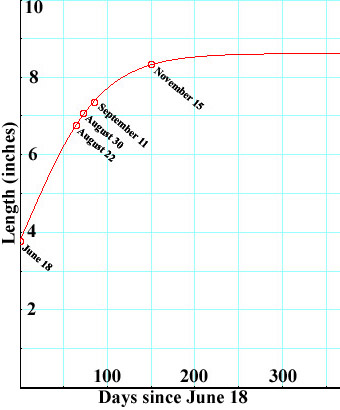
Return to Lucilla's Front Page